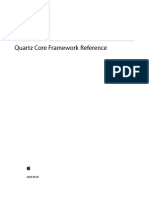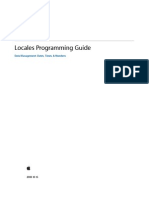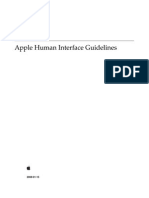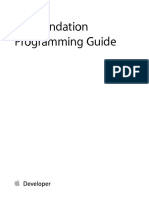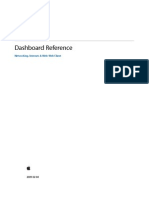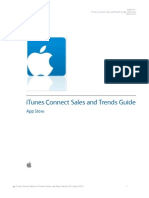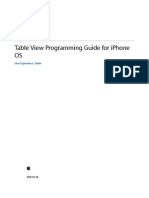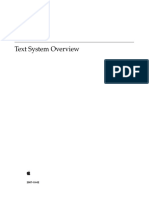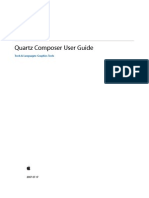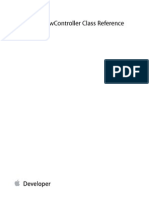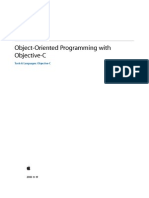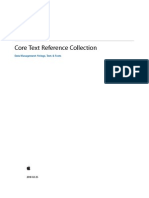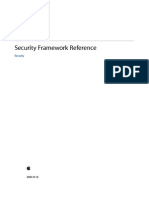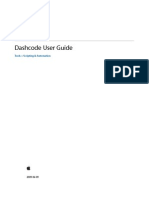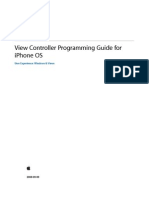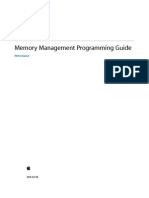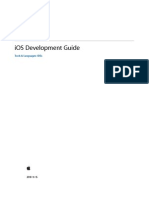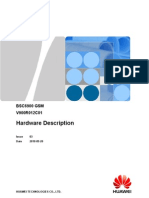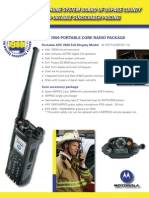0 ratings0% found this document useful (0 votes)
124 viewsHow To Test Your Itunes LP
How To Test Your Itunes LP
Uploaded by
MONSTRE_MIKEThe document provides instructions for testing iTunes LPs and extras on Mac, PC, and Apple TV. It details setting up iTunes for debugging, using fake XIDs during development, and ensuring compatibility with Apple TV.
Copyright:
Attribution Non-Commercial (BY-NC)
Available Formats
Download as PDF, TXT or read online from Scribd
How To Test Your Itunes LP
How To Test Your Itunes LP
Uploaded by
MONSTRE_MIKE0 ratings0% found this document useful (0 votes)
124 views4 pagesThe document provides instructions for testing iTunes LPs and extras on Mac, PC, and Apple TV. It details setting up iTunes for debugging, using fake XIDs during development, and ensuring compatibility with Apple TV.
Original Description:
This will let you test your iTunes LP for windows.
Original Title
How To Test your iTunes LP
Copyright
© Attribution Non-Commercial (BY-NC)
Available Formats
PDF, TXT or read online from Scribd
Share this document
Did you find this document useful?
Is this content inappropriate?
The document provides instructions for testing iTunes LPs and extras on Mac, PC, and Apple TV. It details setting up iTunes for debugging, using fake XIDs during development, and ensuring compatibility with Apple TV.
Copyright:
Attribution Non-Commercial (BY-NC)
Available Formats
Download as PDF, TXT or read online from Scribd
Download as pdf or txt
0 ratings0% found this document useful (0 votes)
124 views4 pagesHow To Test Your Itunes LP
How To Test Your Itunes LP
Uploaded by
MONSTRE_MIKEThe document provides instructions for testing iTunes LPs and extras on Mac, PC, and Apple TV. It details setting up iTunes for debugging, using fake XIDs during development, and ensuring compatibility with Apple TV.
Copyright:
Attribution Non-Commercial (BY-NC)
Available Formats
Download as PDF, TXT or read online from Scribd
Download as pdf or txt
You are on page 1of 4
iTunes Extras/iTunes LP Development How to Test v1.
page 1
iTunes Extras/iTunes LP Development: How to Test v1.0
11-18-2009 2009 Apple Inc. All rights reserved
iTunes Extras/iTunes LP Development How to Test v1.0
page 2
Contents
Testing for a Mac or PC Testing for Apple TV Creating XIDs for Testing
3 4 4
2009 Apple Inc. All rights reserved
iTunes Extras/iTunes LP Development How to Test v1.0
page 3
Testing for a Mac or PC
To test the functionality of your iTunes LP or iTunes Extras on a Mac or PC, you can use Safari to perform initial tests during development. Drag the index.html file into Safari and click to test basic navigation. You can also use the keyboard arrows to navigate as you would on Apple TV with the 6-button remote. If you've used the provided templates, you will hear a "bonk" noise when using the arrows and you reach the end of a navigable plane, just like you would on Apple TV. Note that your core assets (movies and albums/tracks) will not work through a browser and instead will need to be played through iTunes in the following manner: 1. Set up iTunes for debugging and editing XIDs by running the following commands in the command line prior to launching iTunes. Edit HTML: To allow right click Inspect Element when in an iTunes LP or iTunes Extras: Mac: defaults write com.apple.iTunes WebKitDeveloperExtras -bool true Windows: iTunes.exe /setPrefIntWebKitDeveloperExtras1 To undo this change to iTunes, run this command: Mac: defaults write com.apple.iTunes WebKitDeveloperExtras -bool false Windows: iTunes.exe /setPrefIntWebKitDeveloperExtras0 Asset XID editing: To change the Grouping field in Get Info to XID . Mac: defaults write com.apple.iTunes booklet-authoring-mode 1 Windows: iTunes.exe /setPrefIntbooklet-authoring-mode1 To undo this change to iTunes, run this command: Mac: defaults write com.apple.iTunes booklet-authoring-mode 0 Windows: iTunes.exe /setPrefIntbooklet-authoring-mode0 2. Prepare fake XIDs (if real XIDs are not yet available for your songs or movie - see section uuid below) and add it to the core asset by launching the Get Info panel and adjusting the "Grouping" field (see above). A mocked up core movie asset with chapters (iTunes Extras Test Video.m4v) has been provided for you to download and review chapter functionality. You can edit the "Grouping" field to remove the ID "TEST:uuid:F97CCBE5-EBD4-4A30-A13A-6B5052EE6A04" and replace it with your own test or real XID. Add same XID you've placed on core asset in the data.js file. Create an .itlp or .ite package by simply adding ".itlp" or ".ite" to your folder containing the index.html file. If you are using a Mac, this will turn the folder into a package in the Finder; to continue editing, you'll have to right click on the package and choose "Open Package Contents" from the menu. Then drag that package into iTunes along with the core asset (album or movie) or the mocked up core movie asset "iTunes Extras Test Video". Make sure that your background audio is present in the "audio" folder, and your bonus content (audio or video) is present in the "videos" folder. These files must be m4vs (for videos) or m4as (for audio only extras) to function properly.
3. 4.
5.
2009 Apple Inc. All rights reserved
iTunes Extras/iTunes LP Development How to Test v1.0
page 4
Testing for Apple TV
To test the functionality of your iTunes LP or iTunes Extras on Apple TV: 1. Make sure that your manifest.xml file allows your iTunes LP or iTunes Extras to play on Apple TV by including this section: <requirements> <supported_platforms> <platform name="iTunes" minimum_version="9.0"/> <platform name="AppleTV" minimum_version="3.0"/> </supported_platforms> </requirements> Make sure your core assets and the iTunes LP or iTunes Extras share the same "Album" Name in the Get Info Panel. That way, they will correctly show up on the Apple TV. Note that this is for testing only. Sync the core asset and the iTunes LP or iTunes Extras over from iTunes to Apple TV.
2.
3.
Creating XIDs for Testing
If you are testing iTunes LP or iTunes Extras prior to submission to the iTunes Store, and you have not yet finalized the identifiers for your content, you may wish to generate temporary XIDs for testing. The best way to do this is to use the reserved prefix TEST, combined with the uuid scheme. To generate an XID using the TEST prefix and the uuid scheme, first generate a unique UUID for the track or video to be temporarily identified with the XID. You can do this using the uuidgen command on Mac OS X; for example: $ uuidgen 94C2C4BC-E57B-4CA6-B7C9-AA9EE8A63298 Then, create your XID by prepending "TEST:uuid:" to your UUID. For example, for the UUID above, you would use the following XID: TEST:uuid:94C2C4BC-E57B-4CA6-B7C9-AA9EE8A63298 For more information on XIDs, see the Development Guide.
2009 Apple Inc. All rights reserved
You might also like
- Quartz Core Ref CollectionDocument400 pagesQuartz Core Ref CollectionhousirNo ratings yet
- Apps Payments Finance Reports GuideDocument16 pagesApps Payments Finance Reports GuideNguyễnMinhQuânNo ratings yet
- CFLocalesDocument18 pagesCFLocalesmumu311No ratings yet
- OS X - Human Interface GuidelinesDocument402 pagesOS X - Human Interface Guidelinesjimbeaubien100% (3)
- AVFoundationPG PDFDocument112 pagesAVFoundationPG PDFDejan KumricNo ratings yet
- iTMF SpecificationDocument24 pagesiTMF Specificationbennie00No ratings yet
- Ipod Notes Feature GuideDocument54 pagesIpod Notes Feature GuideMax MooreNo ratings yet
- Xcode Release NotesDocument142 pagesXcode Release Notesโยอันนา ยุนอา แคทเธอรีน เอี่ยมสุวรรณNo ratings yet
- Accelerate FWRefDocument556 pagesAccelerate FWRefMaximillian NogueiraNo ratings yet
- Dashboard Reference: Networking, Internet, & Web: Web ClientDocument24 pagesDashboard Reference: Networking, Internet, & Web: Web Clientalbertonunez@udc.esNo ratings yet
- App Store Reporting InstructionsDocument31 pagesApp Store Reporting InstructionsThanakrit WangsajantanontNo ratings yet
- Table View Programming Guide For Iphone Os: User Experience: TablesDocument84 pagesTable View Programming Guide For Iphone Os: User Experience: TablesRuben FloresNo ratings yet
- Text ArchitectureDocument49 pagesText Architecturepippopippa2013No ratings yet
- Quartz Composer User GuideDocument72 pagesQuartz Composer User GuidelspriceNo ratings yet
- CFBundlesDocument53 pagesCFBundlesОлег ЛевченкоNo ratings yet
- UIActivityViewController Class123Document9 pagesUIActivityViewController Class123Qamar SaleemNo ratings yet
- Apple ManualDocument220 pagesApple ManualTommaso ScigliuzzoNo ratings yet
- Xcode Tools 2.4.1 For Mac OS X Version 10.4.x (Tiger) : CompatibilityDocument4 pagesXcode Tools 2.4.1 For Mac OS X Version 10.4.x (Tiger) : CompatibilityshdwsclanNo ratings yet
- Object-Oriented Programming With Objective-CDocument40 pagesObject-Oriented Programming With Objective-Cbbobbison4623No ratings yet
- Dictionary Services Prog GuideDocument32 pagesDictionary Services Prog GuideKirftNo ratings yet
- CoreText Framework RefDocument178 pagesCoreText Framework RefShah ParilNo ratings yet
- Drawing With Quartz 2 DDocument229 pagesDrawing With Quartz 2 DIma6_No ratings yet
- QTFFDocument454 pagesQTFFvanonetNo ratings yet
- Apple ManualDocument83 pagesApple ManualTommaso ScigliuzzoNo ratings yet
- Whats New in OSXDocument103 pagesWhats New in OSXโยอันนา ยุนอา แคทเธอรีน เอี่ยมสุวรรณNo ratings yet
- OSX Technology OverviewDocument183 pagesOSX Technology OverviewSworna VidhyaNo ratings yet
- QTFFDocument446 pagesQTFFKitabul HijriNo ratings yet
- I Phone App Programming Guide - GuidersDocument153 pagesI Phone App Programming Guide - GuidersSpaceerXNo ratings yet
- CoreAnimation Guide PDFDocument97 pagesCoreAnimation Guide PDFjose cegriNo ratings yet
- UIApplicationDelegate ProtocolDocument38 pagesUIApplicationDelegate ProtocolQamar SaleemNo ratings yet
- Fairplay Streaming OverviewDocument12 pagesFairplay Streaming OverviewMihai PanţiruNo ratings yet
- Apple iOS Security Framework ReferenceDocument74 pagesApple iOS Security Framework Referencej123smithNo ratings yet
- IOS Core AnimationDocument97 pagesIOS Core AnimationLeo LuNo ratings yet
- Audio Queue Programming GuideDocument63 pagesAudio Queue Programming Guide이효준No ratings yet
- QTFFDocument356 pagesQTFFrijoiNo ratings yet
- Dashcode User Guide: Tools Scripting & AutomationDocument96 pagesDashcode User Guide: Tools Scripting & AutomationAndrew BonnerNo ratings yet
- Apple Javascript Coding Guidelines: Tools & Languages: Other LanguagesDocument26 pagesApple Javascript Coding Guidelines: Tools & Languages: Other LanguagesMihajlo AndjelicNo ratings yet
- Porting UnixDocument80 pagesPorting UnixthiendNo ratings yet
- Apple Developer's Resource - Over-the-Air Profile Delivery & ConfigurationDocument32 pagesApple Developer's Resource - Over-the-Air Profile Delivery & ConfigurationPointAboutNo ratings yet
- StoreKit CollectionDocument54 pagesStoreKit CollectionPraveen KumarNo ratings yet
- System - Overview 06 - 02 PDFDocument320 pagesSystem - Overview 06 - 02 PDFJulia SnigurNo ratings yet
- View Controller PGfori Phone OSDocument46 pagesView Controller PGfori Phone OSapi-3834772100% (1)
- Memory Management Programming Guide: PerformanceDocument28 pagesMemory Management Programming Guide: PerformanceAnh NguyenNo ratings yet
- IOS Multi ThreadingDocument99 pagesIOS Multi Threadingp_sudheersNo ratings yet
- Extensibility PGDocument96 pagesExtensibility PGโยอันนา ยุนอา แคทเธอรีน เอี่ยมสุวรรณNo ratings yet
- ThunderboltDevice Driver Programming Guide by AppleDocument29 pagesThunderboltDevice Driver Programming Guide by Applejigg1777No ratings yet
- UIButton ClassDocument32 pagesUIButton Classadil054No ratings yet
- Text Programming Guide For iOSDocument106 pagesText Programming Guide For iOSPetr MánekNo ratings yet
- Drawing Printingi OSDocument88 pagesDrawing Printingi OSWovgh LastNo ratings yet
- Safari Css Animation GuideDocument32 pagesSafari Css Animation GuideTHuRStoN!No ratings yet
- CoreMotion Reference PDFDocument77 pagesCoreMotion Reference PDFhoeelin8256No ratings yet
- Pages Exam PrepDocument15 pagesPages Exam PrepsumitmohanguptaNo ratings yet
- iOS Development GuideDocument100 pagesiOS Development Guideursuresh_14No ratings yet
- Support 10.10 Exam PrepDocument50 pagesSupport 10.10 Exam PrepbthangarajNo ratings yet
- Core Location FrameworkDocument64 pagesCore Location FrameworkDennis WongNo ratings yet
- Oracle Solaris 11 System Virtualization Complete Self-Assessment GuideFrom EverandOracle Solaris 11 System Virtualization Complete Self-Assessment GuideNo ratings yet
- About Itunes: What'S New in Itunes 7.4.3Document2 pagesAbout Itunes: What'S New in Itunes 7.4.3Cao Thanh LongNo ratings yet
- Apple TV - Initial ConfigurationDocument3 pagesApple TV - Initial ConfigurationRobinNo ratings yet
- Preparing Files I Tune SuDocument4 pagesPreparing Files I Tune Susdstay2011No ratings yet
- TrancientDocument3 pagesTrancientReneNo ratings yet
- BSNL TTA 2012 Question PaperDocument12 pagesBSNL TTA 2012 Question PaperSatish BojjawarNo ratings yet
- WEG SSW7000 Medium Voltage Soft Starter 50031014 Brochure enDocument20 pagesWEG SSW7000 Medium Voltage Soft Starter 50031014 Brochure enMZitronNo ratings yet
- DHK0034 DHK0082 DHK4090 DHK4360 DHK1814 DHK3838 DHK4074Document7 pagesDHK0034 DHK0082 DHK4090 DHK4360 DHK1814 DHK3838 DHK4074Mahbub UzzamanNo ratings yet
- Boge Energy Efficient Air Compressor or Master ControllersDocument12 pagesBoge Energy Efficient Air Compressor or Master ControllersAir Repair, LLCNo ratings yet
- BSC6900+GSM+Hardware+Description (V900R012C01 03)Document267 pagesBSC6900+GSM+Hardware+Description (V900R012C01 03)Robert Canteli JudolieevNo ratings yet
- M31 Knig9404 Ism C31 PDFDocument33 pagesM31 Knig9404 Ism C31 PDFnorma_jeannNo ratings yet
- AmirDocument5 pagesAmirMohammad Munazir AliNo ratings yet
- Module: From Ideas To Implementation Chapter 10: Cathode Rays and The Development of Television (Questions, Pages 185-186)Document4 pagesModule: From Ideas To Implementation Chapter 10: Cathode Rays and The Development of Television (Questions, Pages 185-186)bananananananaaaNo ratings yet
- Pscad Model: CalculationDocument12 pagesPscad Model: CalculationErandikaNo ratings yet
- Switch Installation Guide: Warnings and ConsiderationsDocument4 pagesSwitch Installation Guide: Warnings and ConsiderationsAndres PARDO ARAQUENo ratings yet
- APX Core PackageDocument4 pagesAPX Core PackageRick WilsonNo ratings yet
- CSEC IT Theory Exam Questions 93 - 96Document9 pagesCSEC IT Theory Exam Questions 93 - 96Ronaldo DegazonNo ratings yet
- Voip Tech BulletinDocument2 pagesVoip Tech BulletinIzzit LoadedNo ratings yet
- Short Channel Effects in MosfetsDocument3 pagesShort Channel Effects in Mosfetsutkarsh gupta100% (1)
- Counting AtomsDocument15 pagesCounting AtomsRobert Emrich100% (1)
- E 180 000 2 11 13Document408 pagesE 180 000 2 11 13spaszko54No ratings yet
- 48366806076Document2 pages48366806076Islami Punjabi Bayan SM HadiNo ratings yet
- PC Corner PricelistDocument2 pagesPC Corner PricelistPeter AngeloNo ratings yet
- Metode Kerja Ultrasonic Drilling Monitor (KODEN)Document6 pagesMetode Kerja Ultrasonic Drilling Monitor (KODEN)jimdabrond100% (2)
- Waveguide Modeling For Naval RadarDocument5 pagesWaveguide Modeling For Naval Radarriyaz100% (1)
- Solucionario Fisica Moderna Schaum DescargarDocument2 pagesSolucionario Fisica Moderna Schaum DescargarHenry PayulNo ratings yet
- LMR-111D, Installation Instructions 4189340235 UKDocument4 pagesLMR-111D, Installation Instructions 4189340235 UKvijayasiva86No ratings yet
- Problem CacheMemory1Document9 pagesProblem CacheMemory1buulaaatNo ratings yet
- 4.1.10 Axis T8134 Midspan 60WDocument2 pages4.1.10 Axis T8134 Midspan 60WnisarahmedgfecNo ratings yet
- User Guide: Ver.2.0eDocument51 pagesUser Guide: Ver.2.0ehihiNo ratings yet
- Float Level SensorDocument12 pagesFloat Level SensorAmira KormainNo ratings yet
- Week 11-Induction Machine - ELEC2300Document28 pagesWeek 11-Induction Machine - ELEC2300Look AxxNo ratings yet
- Replacing Barber Colman Synchronisers and Load Sharing Units With The UnigenDocument5 pagesReplacing Barber Colman Synchronisers and Load Sharing Units With The UnigenejazNo ratings yet
